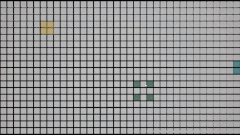Müzik Verilerini Kullanan İnteraktif Duvar Tasarımı
Tarih boyunca müzik ve mimarlık disiplini birbirine öykünmüştür. Bu öykünmeler her iki sanat dalını da beslemiş ve daha ileri taşımıştır. Dijitalleşme çağında hesaplamalı tasarım yöntemlerinin gelişmesi ile bu öykünmeler yerini her iki sanat dalı arasındaki çizgiyi silikleştirerek daha homojen, disiplinler arası çalışmalara bırakmıştır. Nitekim bu çalışma da müziğin akışkan yapısının mimari bir öge olan duvar üzerinde görselleştirilebilmesi üzerinedir. Çalışma kapsamında, kullanıcının dokunması ile aktif hale gelen, kullanıcı etkileşimi anında ortamda çalan müziğin genlik verileri çekilerek bu verilerin hücresel özdevinim kural setlerinin girdisi olarak kullanılması ile kullanıcı ve müzik etkileşimli bir duvar tasarlanmıştır. Tasarlanan bu duvar eşit panellerden oluşmaktadır ve kullanıcı bu panellere dokunarak, dokunduğu hücreleri canlı duruma getirir. Canlı duruma getirilen paneller, her bir kullanıcı için özel bir renk kodu ile temsil edilir. Hücresel özdevinimin komşuluk ilişkilerinden faydalanarak, kullanıcının etkilediği tek bir panelin müzik genliğinin artışı ve azalışına doğru orantılı olarak komşu duvar panelleri üzerinde yayılmacı ve sönümlenen karakter gösterebilmesi sağlanmaktadır. Bu noktada hücresel özdevinim, ses dalgalarını temsil edecek bir aracı enstrüman olarak kullanılmıştır. Müzik ve kullanıcı etkileşimi ile sürekli bir devinim halinde görselleştirilen durumlar belirme kavramı altında incelenmiştir. Tasarım düğüm tabanlı görsel komut arayüzü Blueprint’te kodlanmış ve simülasyon Unreal Engine 4.26 içerisinde çalıştırılmıştır. Yapılan bu ön çalışma müziğin yalnızca görselleştirilmesinin ötesinde daha ileri çalışmalar için bir form bulma aracı haline gelebileceğini ummaktadır.
Interactive Wall Design Using Music Data
Throughout history, the discipline of music and architecture have emulated each other. These imitations fed and carried both branches of art further. With the development of computational design methods in the era of digitalization, these imitations have been replaced by more homogeneous, interdisciplinary studies by blurring the line between both branches of art. This study is about visualizing the fluid structure of music on a wall, which is an architectural element. Within the scope of the study, a user and music interactive wall was designed by taking the amplitude data of the music that is activated by the user’s touch and played in the environment at the sequence of user interaction, and using this data as the input of the cellular automata rule sets. This designed wall consists of equal panels, and as the user touches these panels, bringing the cells to life. The wall panels that have become alive are represented with a unique color code for each user. By using the neighborhood relations of a cellular automaton, a single wall panel, which is affected by the user, can display an expanding and damping character on the neighbor wall panels in direct proportion to the increase and decrease of the music amplitude. At this point, the cellular automaton has been used as an intermediary instrument to represent sound waves. The motives that are visualized in a continuous motion with music and user interaction, are examined under the concept of emergence. The design was coded in the node-based visual command interface Blueprint and, the simulation is running in Unreal Engine 4.26. It is hoped that this preliminary study can become a form-finding tool for further studies beyond just the visualization of music.
© 2021 Istanbul Technical University Graduate School, Department of Informatics, Architectural Design Computing Program. All Rights Reserved
